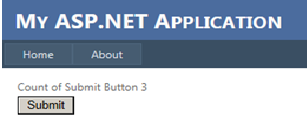To preserve the data during the page post back and page load hidden fields are used . In ASP.NET it is used by view state . Hidden fields are input fields and not visible to the user . You can add hidden fields on your page. You can also store the data in these fields but the data is stored in its value property . The information which is stored in the hidden fields can be rendered for a single page . Using the hidden fields the page should be submitted to the server .
An example to use the hidden field :
Default.aspx
<asp:Content ID="HeaderContent" runat="server" ContentPlaceHolderID="HeadContent"> asp:Content>
<asp:Content ID="BodyContent" runat="server" ContentPlaceHolderID="MainContent"> <asp:HiddenField ID="Countinghiddenfield" runat="server" /> <table>
<tr>
<td>
<asp:Label ID="lbltext" runat="server" Text="Label">asp:Label>
td>
tr>
<td>
<asp:Button ID="Submitbutton" runat="server" Text="Submit" />
In the code behind file
Default.aspx.cs
using System;
using System.Configuration;
using System.Data;
using System.Linq;
using System.Web;
using System.Web.Security;
using System.Web.UI;
using System.Web.UI.HtmlControls;
using System.Web.UI.WebControls;
using System.Web.UI.WebControls.WebParts;
using System.Xml.Linq;
namespace Clientstatehidden
{
public partial class _Default : System.Web.UI.Page
{
protected void Page_Load(object sender, EventArgs e)
{
int clicks;
int.TryParse(Countinghiddenfield.Value, out clicks);
clicks++;
Countinghiddenfield.Value = clicks.ToString();
lbltext.Text = "Count of Submit Button " + Countinghiddenfield.Value;
}
}
}
The output screen shot of the above program .
